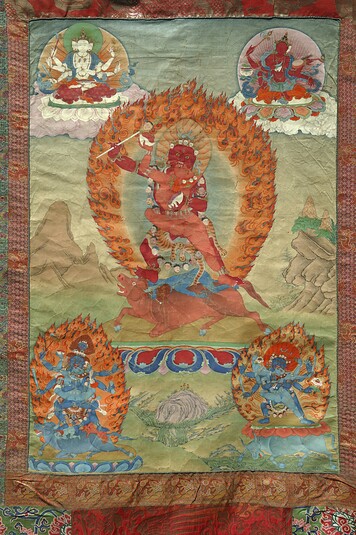
Item: Yamari, Rakta (Buddhist Deity)
| Origin Location | Tibet |
|---|---|
| Date Range | 1960 - |
| Lineages | Karma (Kagyu) and Buddhist |
| Collection | Shechen Archives - photographs |
Classification: Deity
Rakta Yamari (Tibetan: shin je she mar. English: the Red Enemy of Death); an emanation of the bodhisattva of wisdom Manjushri.

Sanskrit: Rakta Yamari Tibetan: Shin je she mar
Tibetan: Shin je she mar
With one face and two hands the right holds aloft a vajra stick ready to strike and the left a skullcup held to the heart embracing the consort Vajra Vetali. Very fierce in appearance with the hair flowing upwards like fire, he has large eyes and a gaping open mouth. The right leg is bent and the left extended standing above a corpse seat and reclining red buffalo. The consort holds a skullcup with the left hand and stands with the right leg down and the left embracing the partner; in the same fierce demeanor as Rakta Yamari. Wearing bone and jewel ornaments, silk garments, he wears a necklace of fifty freshly severed heads and a lower garment of tiger skin. She wears a necklace of skulls; completely surrounded by the flames of pristine awareness.
"Rakta Yamari, [with] one face and two hands. The right [hand] holds aloft a white stick marked with a fresh yellow human head. The left holds a blood filled skullcup embracing the consort of self light. The face has bared fangs and a curled tongue [and] three round red eyes. Having yellow hair bristling upwards [and] a lower garment of tiger skin. Adorned with the eight great nagas, a necklace of fifty fresh heads and a crown of five dry skulls. Standing on a red buffalo in a manner with the left leg extended." (Konchog Lhundrub, based on the Bari Gyatsa of Bari Lotsawa Rinchen Drag, 11th century).
At the top right corner is "Vajra Sarasvati: wrathful and secret Vajra Sarasvati. Vajra Sarasvati, with three faces and six hands. The main face is red, the right blue and the left white. The three right hands hold, a lotus, sword and curved knife. The three left, a wheel, jewel and skullcup. Having jewel ornaments and garments of silk. Seated in a manner of ease with the left leg extended." (Konchog Lhundrub, based on the Bari Gyatsa of Bari Lotsawa Rinchen Drag, 11th century). This form of Vajra Sarasvati arises from the Krishna Yamari Tantra.
At the top left is Dharmadhatu Manjushri. "White Dharmadhatu Vagishvara, with four white faces, eight hands, the first two in the Dharma teaching gesture. The three lower right hold a sword, arrow and vajra. The three lower left, a Prajnaparamita book, bow and bell. With the same ornaments and garments. Seated in the vajrasana [posture]."
At the bottom right is "Krishna Yamari, [three faces, six hands]. He is the same as all the other [previous Yamaris], with three faces and six hands, the body and main face are blue, the right white and the left red. With six hands, the three right hold, a wheel, sword and staff, the three left, a body impaled on a strong vetali tree, vajra and noose." (Konchog Lhundrub, based on the Bari Gyatsa of Bari Lotsawa Rinchen Drag, 11th century).
At the bottom left is " Krishna Yamari, [six faces, six hands]. Yamari has a body black in colour, six faces and six hands. The main face and one above it are black. The right face and one above it are white. The left face and one above it are red. The first two hands hold a vajra and bell crossed at the heart. The middle two hold a skullcup and lasso. The last two hold a sword and staff. Standing with the front two legs in the vajrasana [posture], the middle two have the right bent and the left straight [and] the last two have the left bent and the right straight. The hair, eyebrows and beard are orange and flowing upwards, with a crown of five dry skulls and a necklace of fifty fresh [skulls]. Adorned with snake and jewel ornaments. Having a tiger skin as a lower garment." (Konchog Lhundrub, based on the Bari Gyatsa of Bari Lotsawa Rinchen Drag, 11th century).
The Main Indian Lineage: Vajradhara, Manjushri Yamari, Jnanadakini, mahasiddha Virupa, Dombi Heruka, Viratipa, Matigarbha, Gambhiramati, Vajrasana Ashokashri, Nishkalangka Devi, Revendra Prabha, Chag Lotsawa Choje Pal (a Tibetan), etc. There were many lineages of Rakta Yamari to enter Tibet and most are traced back to the mahasiddha Virupa.
The painting is most likely by the artist Tangla Tsewang (1902-1989 [p1pd8264]) of Palpung Monastery.
Jeff Watt 7-2010
Buddhist Deity: Yamari, Rakta Art History
Painting Set: Twenty-seven Deities (Situ)
Collection of Shechen Archives: Gallery II
Painting Style: Palpung - Wrathful Deities
Buddhist Deity: Yamari, Rakta (with corpse)
Buddhist Deity: Yamari, Rakta (Religious Context)
Buddhist Deity: Yamari, Rakta, Main Page
Buddhist Deity: Yamari, Rakta (Masterworks)

